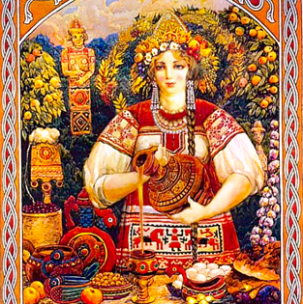Slavic Mythology
*cover image – Mokosh (Ukrainian/Slavic Goddess of fertility, water and women)
MOKOSH is the life-giving goddess in ancient Slavic mythology, inherited from the pre-Indo-European pantheon and debased during the early Christian era. She is a goddess of fertility, midwifery, water, and women in old Ukrainian mythology.
Mokosh is Moist Mother Earth (Mati-Syra-Zemlya). She is also the Mother of the soil.
Mokosh also spins the web of life and death as she supplies the necessities of survival. She wanders during Lent disguised as a woman, visiting houses and doing housework; at night strands of fleece are laid beside the stoves for her.
Mokosh also rules domestic activities, as well as marriage rites and family affairs.
Slavic Religion.
Slavic religion, pre-Christian religious practices among the Slavs of Eastern Europe. There is only fragmentary and scattered information about the myths and legends of the pagan Slavs, and it is not possible to trace the history of their religion or to reconstruct the whole Slavic pantheon. Nevertheless, there were certain common beliefs among most pre-Christian Slavs. It is generally thought that the earliest Slavic religious beliefs were based on the principle that the whole natural world is inhabited and directed by spirits or mysterious forces. Later, particularly in areas where the Slavs had a more organized cultural life and were integrated with foreign peoples, the spiritual beliefs became less rustic, and the vague spirits of nature were anthropomorphized into divinities with special powers and functions.Beliefs and religious practices of the ancient Slavic peoples of East Europe, including the Russians, Ukrainians, Poles, Czechs, Slovaks, Serbs, Croats, and Slovenes. Most Slavic mythologies hold that God ordered the devil to bring up a handful of sand from the bottom of the sea and created the land from it. Slavic religion was often characterized by dualism, with a Black God named in curses and a White God invoked to obtain protection or mercy. Lightning and fire gods were also common. The ancient Russians appear to have erected their idols outdoors, but the Baltic Slavs built temples and enclosed sacred places, where festivals were held and animal and human sacrifices occurred. Such festivals also often included communal banquets at which the flesh of sacrificial animals was consumed.
Slavic pantheon contains all supernatural powers, that have characteristics of gods in its real sense.
It is not proper for the Pantheon to include different spirits or demons, anthropomorphe natural objects, fairy creatures and personifications. Pantheon, the so called by ancient Slavs “svarga” (skies), represents a congregation of philosophically improved, complex, personified, extraordinary forces, typical for the heathen religious concepts of the Slavs till their baptising.

